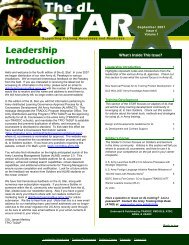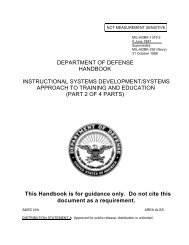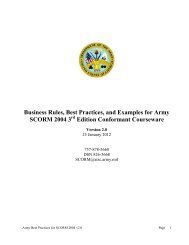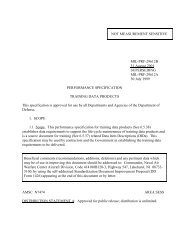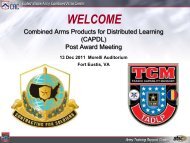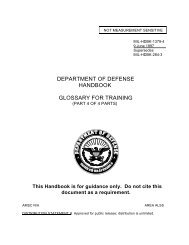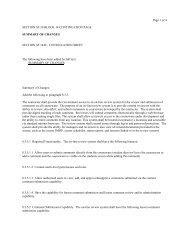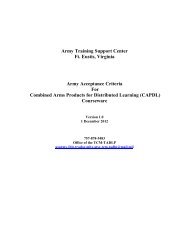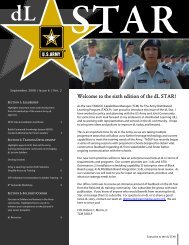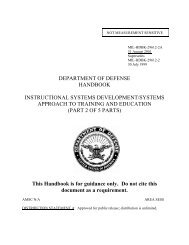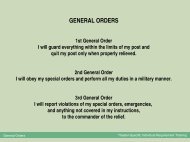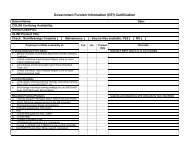dlxxi contract - U. S. Army Training Support Center
dlxxi contract - U. S. Army Training Support Center
dlxxi contract - U. S. Army Training Support Center
Create successful ePaper yourself
Turn your PDF publications into a flip-book with our unique Google optimized e-Paper software.
C.3 Scope<br />
C.3.1 The <strong>contract</strong>or shall evaluate, analyze, design, develop, implement, manage, and<br />
deliver on a delivery order basis training products and services for federal government<br />
agencies that support the programs listed in paragraph C-2. Work under this <strong>contract</strong><br />
shall include analysis of training requirements to insure that the materials are developed<br />
and presented in accordance with the most effective and efficient training technologies.<br />
C.3.2 The <strong>contract</strong>or shall design and carry out methodologies to assess training needs,<br />
specify training objectives, develop training content, plan training delivery that is cost<br />
effective and utilizes appropriate training media, produce courseware and/or training<br />
materials, and evaluate training. The industry standard for development of educational<br />
technology is the instructional system design/systems approach to training (ISD/SAT)<br />
process (<strong>Army</strong> uses SAT). The SAT process shall be applied to all training and<br />
developmental efforts to ensure students acquire the knowledge, skills, and abilities<br />
essential for successful job performance. Examples of products of SAT are: instructional<br />
systems based on mission and job performance requirements; courses consisting of<br />
relevant knowledge and skills instruction; and graduates having the necessary knowledge,<br />
skills, and attitudes to perform the mission and/or job. The SAT process is: evaluation,<br />
analysis, design, development, and implementation. The SAT process is explained in<br />
detail in TRADOC Regulation 350-70, <strong>Training</strong> Development Management, Processes,<br />
and Products, and MIL-HDBK 1379-2, Instructional Systems Development/Systems<br />
Approach to <strong>Training</strong> and Education (Part 2 of 4), which can be downloaded from the<br />
internet (See para C.6.4). The <strong>contract</strong>or shall ensure all <strong>contract</strong>or personnel understand<br />
the SAT process and how the process will be used in evaluating, analyzing, designing,<br />
and developing training. The SAT process includes:<br />
C.3.2.1 Evaluation of how well training takes place; can graduates and units perform<br />
assigned mission, and do products support training objectives?<br />
C.3.2.2 Analysis of a need for training. Who gets the training; and what tasks, individual<br />
and collective, require training? Establish performance-based, measurable training<br />
objectives.<br />
C.3.2.3 Design of training to start when, where, and how training takes place and training<br />
resource requirements. Design includes establishing long and short range training<br />
strategies, training media, courseware, and development of performance measurement<br />
documents<br />
C.3.2.4 Development of valid training and training products.<br />
C.3.2.5 Implementation of standardized training at resident and unit training sites and<br />
distribution of training products. Additionally, the <strong>contract</strong>or may be required to provide<br />
train-the-trainer course delivery to enable client agencies to assume instructional<br />
responsibility.<br />
C.3.3 The <strong>contract</strong>or may also perform such tasks as: convert existing courseware to<br />
interactive multimedia instruction (IMI); convert courseware to comply with the standards<br />
of TATSC; configure authoring systems; customize authoring systems; conduct<br />
independent verification and validation of training materials; analyze training effectiveness,



